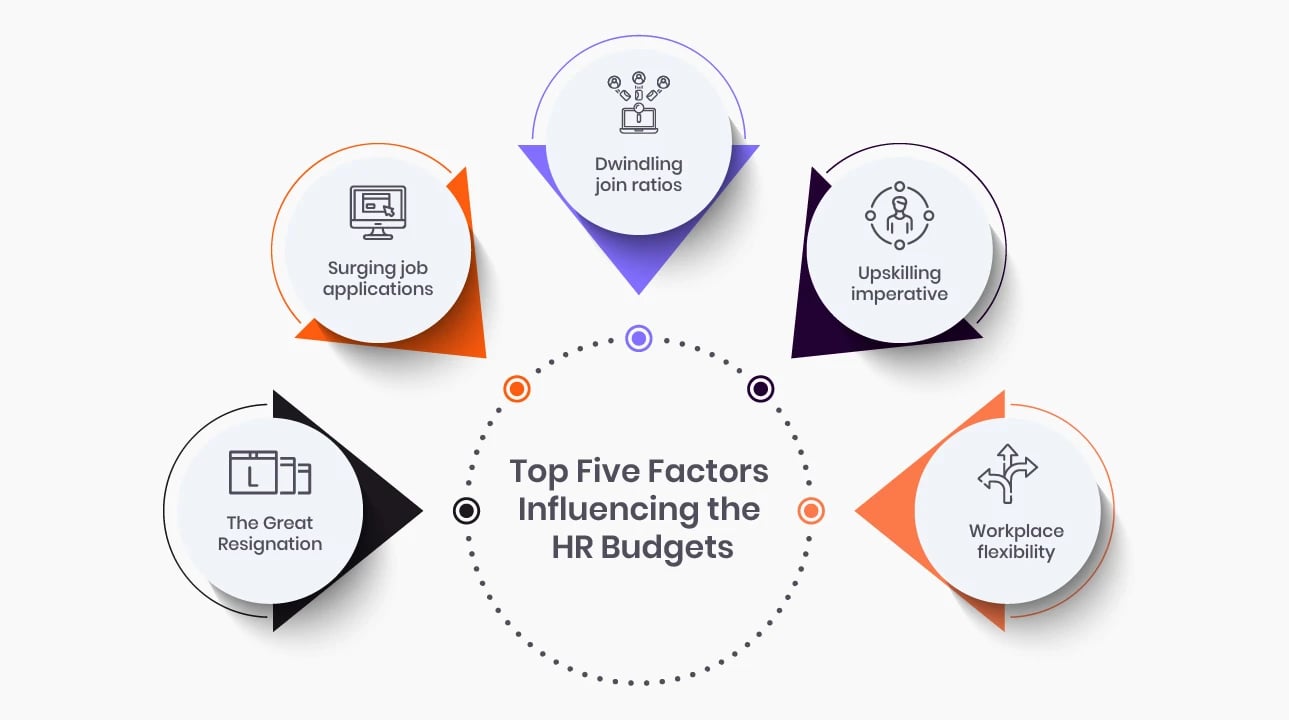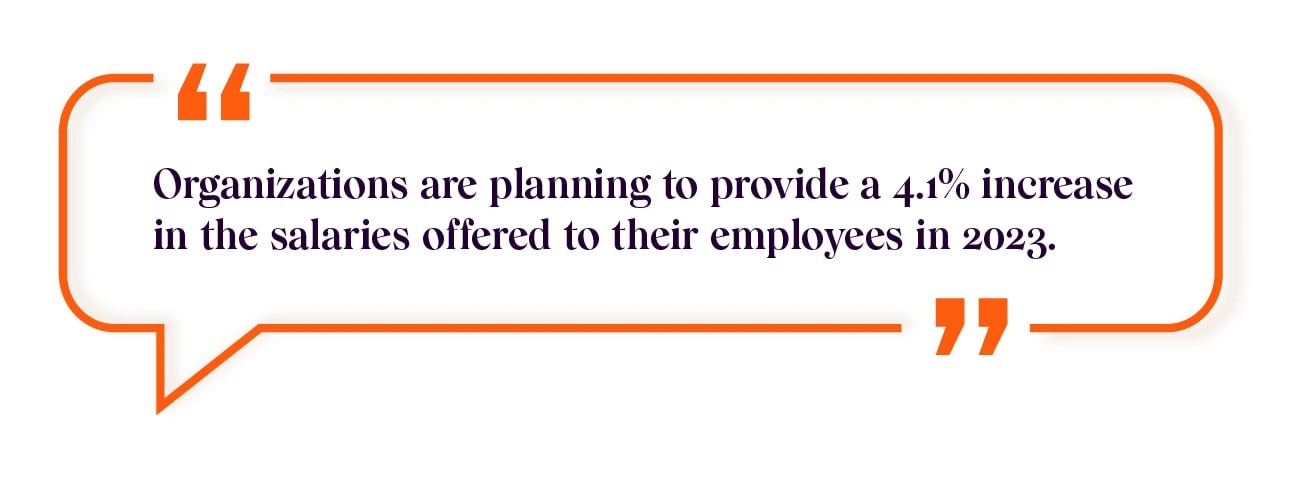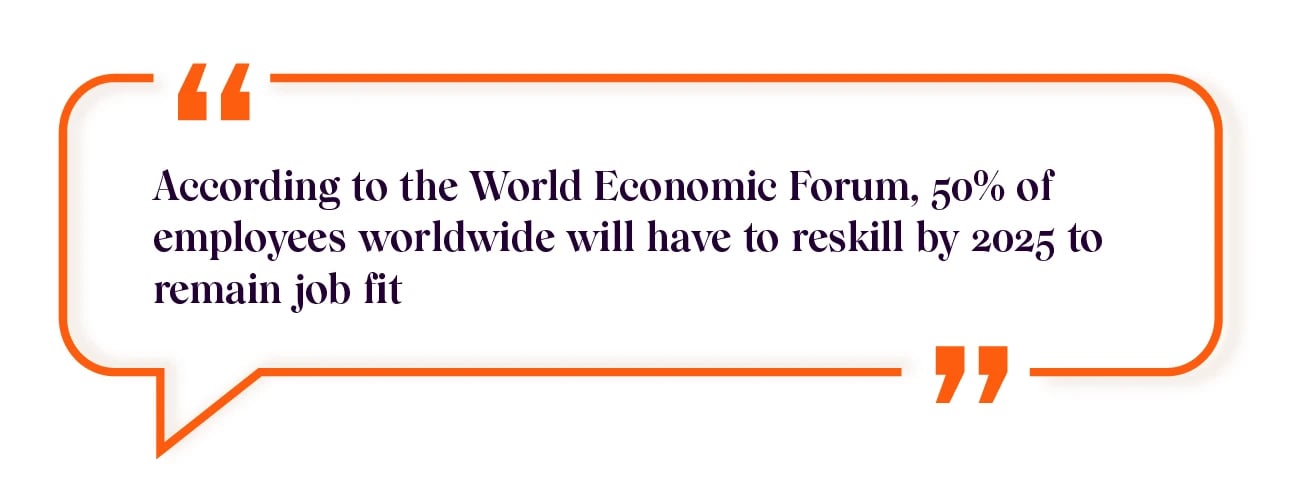A new world of work has emerged. This year has already seen several emerging HR trends, thanks to the changing employee expectations and working styles. Turnovers are rising; wage expectations are skyrocketing; hybrid workforces need modern technologies and training, and labor shortages never seem to cease.
All these factors call for a revision of our current HR budgets and how we prioritize in the future, forcing HR leaders to rethink their strategies and dollars in their quest to attract and retain top talents.
Therefore, as we have moved into the last quarter of 2022, here is my take on the top five factors influencing the HR/TA/TD budgets—in 2023 and beyond. 
I will also share my views on why organizations must align their HR budgets around these elements and focus on attaining a 50% increase in the HR budget in 2023.
The Great Resignation
Employees have started viewing their work life from a fresh perspective after the shifts brought into the work culture by the global pandemic. Because of this, several employees are considering a job change and are willing to test the market.
Nearly 4.5¹ million employees have resigned from their jobs as of March 2022, and one in five people intend to resign from their current job in 2022, making it apparent that this trend isn't going to pace down anytime soon.
In short, "I resign" or "I quit" has become colloquial among many employees.
Each employee has a unique reason for leaving their current organization. However, some general reasons that paved the way for the Great Resignation of 2022 include loss of faith in their company's mission, work culture, lack of career advancement opportunities, financial constraints, dissatisfaction with their jobs, and so forth.
Since several thousand employees are resigning from their organizations, it has created a strong job market with ample opportunities. Employees while leaving their jobs aren't doing so to remain sidelined.
Instead, their priority is to re-enter the job market with vigor to discover new opportunities that align with their interests and play a role in aiding them to be their true self at work.
All these changes, in reality, are setting the stage for the Great Rehire.
While comprehending the Great Resignation from an alternative perspective, it has created 10.72² million job openings in the US alone as of September 2022. This has increased the cost incurred to hire new candidates and retain existing employees, rising the pressure on HR departments to rethink their budget allocations.
For instance, employers must facilitate higher and more competitive wages as part of hiring or retaining employees. A whopping 96% of global organizations have increased their salaries in 2022 as per July 2022 Salary Budget Planning Survey by the WTW³ to recruit new talents and retain their existing skilled workforce. In addition, on average, organizations are planning to provide a 4.1⁴% increase in the salaries offered to their employees in 2023.

Providing competitive packages is just one part of the puzzle. Employers have to look into other aspects, ranging from enhancing job satisfaction to career advancements, for which a higher HR budget allocation will be required in 2023 and beyond.
Surging job applications
Although the labor market has been facing constraints, there has been an influx of job openings and applications. This can be due to the Great Resignation and its counterpart—Great Rehire —happening worldwide. But what's more pertinent for talent teams is to address this increased burden and invest in tools that can help automate time-intensive manual tasks.
With the rising discussions of an impending recession in 2023, along with other concerns, it's integral that organizations invest correctly in measures that can suffice their hiring requirements and aid in nurturing their recruitment pipelines.
Companies will have to rely on artificial intelligence-based tools, starting from a smart and diligent Applicant Tracking System or ATS that can perform various functions, including the auto-rejection of candidates who don't have the required qualifications.
Whether an organization intends to recruit actively or nurture its recruitment funnel, it requires a streamlined recruitment process. For this purpose, incorporating a skills assessment and skills intelligence platform into the HR technological architecture can be highly beneficial. Through this, organizations can reduce costs in the long run and hire skill-fit candidates.
Because of these requisites, organizations are increasingly pressurized to rise their HR funds' allocation toward HR technology and process automation.
A survey⁵ of 600 HR and HR information technology leaders by PwC found that organizations are investing more in HR technology through 2022. This shows that most organizations are willing to spend on their HR tech requirements to improve their business growth.
Dwindling join ratios
As per a PwC⁶ survey, nearly half of the candidates rejected their job offers, especially in high-demand industries. This increase in candidate drop-out rates raises the time-to-hire as the recruiters/hiring managers must reinitiate the entire process from the beginning. It multiplies the opportunity costs resulting in loss of revenue, causing delays in marketing time, affecting customer experience, etc.
The primary reason behind the increase in the no-show-up rate of candidates is the delays in the recruitment process. Companies can overcome this by streamlining their hiring methods by incorporating AI-based HR architecture. Along with this, the offer-to-join ratio dwindles because of a lack of clarity on their job roles, lower compensation, concerns with workplace culture, and an inability to provide digital experiences during the hiring process.
Anyhow, the leading solution for improving the joining ratio is reducing the time-to-hire and enriching the candidate experience. Organizations have to increase their HR budgets and invest in solid employer branding to overcome these issues.
Through this, they can create a quicker hiring process, from identifying the candidates to candidate assessments to selection. Nonetheless, expanding the hiring budget toward improving the join rates can be worth the ROI gained.
The upskilling imperative
 Eighty-five million jobs will become obsolete, and 97 million new jobs will emerge by 2025⁷, according to a Future of Jobs report from the World Economic Forum. By considering this, organizations will have to shift their focus on upskilling, reskilling, and cross-skilling their existing workforce. It is because skills are constantly evolving, and their shelf-life is also depleting. According to the same report, 50% of employees worldwide will have to reskill to remain job-fit by 2025.
Eighty-five million jobs will become obsolete, and 97 million new jobs will emerge by 2025⁷, according to a Future of Jobs report from the World Economic Forum. By considering this, organizations will have to shift their focus on upskilling, reskilling, and cross-skilling their existing workforce. It is because skills are constantly evolving, and their shelf-life is also depleting. According to the same report, 50% of employees worldwide will have to reskill to remain job-fit by 2025.
Therefore, organizations need to concentrate on their learning and development activities to ensure that they have employees with relevant skill sets that align with their business goals and strategies.
Several companies have been lagging in their skills-building activities. It is because most of them fail to understand that skills are the foundation of every job role, from sending a basic email to creating an easy-to-understand presentation.
However, there is a silver lining: organizations have started identifying skills gaps as a core issue and are slowly stepping learning and development initiatives into the executive spotlight.
By bridging the skills gap, organizations can improve their strategic growth and simultaneously enhance employee experience, which is a focal point in building retention rates.
According to a Gartner⁸ survey, including 800 HR leaders across 60 countries, 47% of HR leaders will prioritize employee experience, including creating clear career paths and trajectories, and 42% will focus on the future of work in 2023.
Thus, many organizations have started believing that investing in upskilling, reskilling, or cross-skilling can act as a catalyst in closing the prevalent skills gaps. For the best execution of these activities, there is a need to increase HR budgets to provide the workforce with best-in-class learning opportunities.
Workplace flexibility
Departing from the 9-to-5 work culture, organizations are nowadays closely embracing flextime policies, paving the way for workplace flexibility. Workforce flexibility also includes the adoption of 3-days or 4-day' work weeks, remote work, hybrid work culture, etc.
These employee-centric work models enhance employee retention, engagement rates, morale, and productivity. From the employees’ perspective, this switch brings in self-discipline, adaptability, and so forth.
In the wake of this new reality, job seekers consider workplace flexibility a vital requirement while evaluating their job offers. We can further validate this by a research survey performed by a career builder, as reported in CNBC⁹, confirming that employers offering remote or hybrid positions attract 7x times more applicants.
However, the HR departments would have to roll out different policies and functionalities to accommodate these changes. Most importantly, the complexity of the HR processes increases further while focusing on flexible workplace arrangements, including alternative work schedules, telework, and remote work. HR would have to invest more dollars in team management, security, employment law enforcement, and privacy factors.
Although employees tend to be productive with workplace flexibility, some might face challenges, including digital fatigue and a lack of team dynamics. Therefore, to overcome these constraints, HR must conduct team-building activities and programs from time to time. For this, organizations will have to allocate separate funds within their HR budgets.
Besides, companies must make hefty investments in technology systems, including cloud environments, collaboration tools, and online portals, to enhance operational efficiency in this employee-centric work model.
Workforce flexibility is an excellent shift from the conventional work mode. But it comes with its hurdles. As part of moving ahead and achieving business growth, HR departments will require higher budgets to get the best results from implementing workforce flexibility, which is the need of the hour for many global organizations.
Final thoughts
From dwindling talent pools to surging turnovers, HR and talent acquisition teams have had many challenges in 2022. Thus, an increase in HR budgets will help them navigate the choppy waters, setting them up for long-term success in their hiring campaigns in 2023 and beyond.
|
Are you searching for a skills assessment and skills intelligence platform to enhance your hiring campaigns? Try iMocha! |
References
¹ Tappe, A. (2022). A record 4.5 million Americans quit their jobs in March. CNN Business.https://edition.cnn.com/2022/05/03/economy/job-openings-quits-march/index.html
² (2022). Monthly job openings in the United States from August 2021 to August 2022. Statista.https://www.statista.com/statistics/217943/monthly-job-openings-in-the-united-states/
⁴ Mayer, K. (2022). Employers budgeting big pay raises for 2023. Human Resource Executive. https://hrexecutive.com/employers-budgeting-big-pay-raises-for-2023/
⁵ Staley, D., O’Donnell, C., & Youden, D. (2022). Five ways HR leaders can make the most of their technology investments. PwC.https://www.pwc.com/us/en/tech-effect/cloud/hr-tech-survey.html
⁶ Higgins-Dunn, N. (2020). Nearly half of job seekers in high-demand industries rejected a job offer after an interview—here’s why. CNBC. https://www.cnbc.com/2020/01/28/half-of-job-seekers-rejected-a-job-offer-after-an-interviewheres-why.html
⁷ Whiting, K. (2020). These are the top 10 job skills of tomorrow – and how long it takes to learn them. World Economic Forum. https://www.weforum.org/agenda/2020/10/top-10-work-skills-of-tomorrow-how-long-it-takes-to-learn-them/
⁸ (n.d.). The Top HR Trends and Priorities For 2023. Gartner. https://www.gartner.com/en/human-resources/trends/top-priorities-for-hr-leaders
⁹ Smith, M. (2022). Remote and hybrid jobs are attracting 7 times more applicants than in-person roles. CNBC. https://www.cnbc.com/2022/03/04/flexible-jobs-are-attracting-7-times-more-applicants-than-in-person-jobs.html

